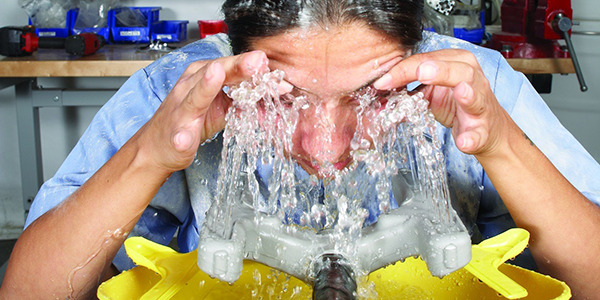
Best Practices for Using Emergency Eyewashes and Showers
Gear up your worksite’s emergency safety equipment to confirm compliance, maximize effectiveness and ensure the greatest protection for employees.
- By Ryan Pfund
- Nov 08, 2023
If your worksite involves any hazards involving harmful chemicals, dusty conditions and/or flammable materials, eyewash stations and safety showers are critical safeguards to have readily available. When installed and used correctly, these plumbed fixtures can provide immediate emergency decontamination resulting from direct exposure to these injurious materials.
Even though emergency fixtures may be installed at a work site, that doesn’t necessarily mean that a facility and its workers are automatically protected. It’s possible that the equipment is poorly maintained, not in good working order, not located near all hazards, unable to dispense tepid water and/or not in compliance with American National Standards Institute (ANSI/ISEA) Z358.1–2014 standards.
That’s where compliance and best practices come into play.
Because emergency eye wash and shower equipment are used by people in serious exposure situations, it is imperative these fixtures are inspected, tested and verified weekly to ensure immediate, reliable and proper usage. Weekly safety equipment tests are required by the ANSI/ISEA (with a more in-depth evaluation to be conducted annually.) Violations for inappropriate or inadequate equipment may result in costly penalties and even life-altering injuries.
Therefore, it is the responsibility of everyone in facility and operations management to ensure compliance and confirm that your equipment is effectively optimizing the best protection for employees.
The following are some best practices to help make sure your facility’s safety program delivers the best outcome in the event of an emergency exposure:
Pinpoint Equipment Placement
Start with a site evaluation to identify at-risk areas, potential hazards and emergency needs, and evaluate factors like product location, water supply, water temperature, accessibility and equipment selection.
Job site evaluations help should not be a one-time event – as with training, testing and maintenance of emergency fixtures. Since work environments are dynamic and change over time, assessments should be conducted annually to ensure the proper type, quantity, installation and location of emergency fixtures. Certain product manufacturers offer complimentary safety shower and eyewash system site surveys to check equipment operation and placement, and compliance with the ANSI/ISEA Z358.1–2014. Further, be sure to conduct site surveys in the event of expanding, relocating or modifying onsite work processes.
This article originally appeared in the November/December 2023 issue of Occupational Health & Safety.